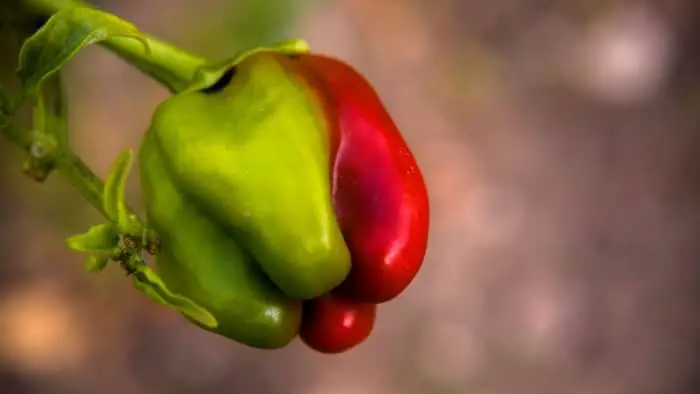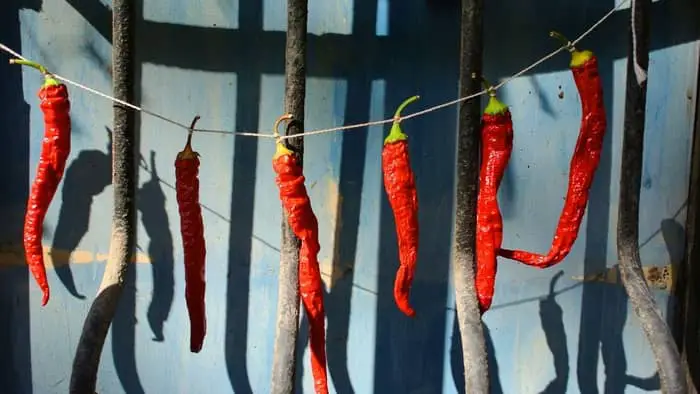Last Updated on October 31, 2022
Why exactly do green peppers turn red is the question we will be answering today. Peppers tend to start as green pepper before turning red on the plant vine.
Peppers are essential cuisines of tropical Asia as well as equatorial America. The pepper plant has been widely grown in South America and Central America and they are now been grown all over the world.
The difference between green peppers and red peppers is purely time. It is the timeframe these fruits have been left to mature on the vine.
Let’s look into more things to note on why green peppers do turn red.
Why Do Green Peppers Turn Red?

So, will green peppers turn red? Why exactly do green peppers turn red? Usually, the colors of peppers or bell peppers are inclined to change from green to yellow, to orange, and then red. These changes depend on how long they are allowed to mature on the vine.
Therefore, green peppers tend to change or turn to red when they are left on the vine. When peppers turn into different colors and finally turn red, this means they have reached their full maturity. Hence, green peppers are the immature fruits of red peppers.
Ideally, almost all peppers will wind up turning red in the long run if they were left on the plant for long.
Green Pepper Turning Red: Which Pepper Is Sweeter?
Green pepper tends to taste slightly bitter while red pepper tastes much better. This is because as the maturity of the pepper progresses, the fruit is liable to become sweeter. Therefore, red pepper which is the last stage of pepper maturity tends to be sweeter than green pepper.
This is one major reason why green peppers are less expensive than red pepper when you shop for them in the grocery store. Red peppers will take more time to reach maturity. But green pepper on the other hand can be derived in less time compared to red peppers.
Helpful Tips On Ripening Or Turning Green Pepper To Red
You may need to harvest your unripe green peppers early probably due to frost or other reasons. So, this may leave you with the unripe green pepper. If you wish to ripen these unripe green peppers to red, here are some tricks on how you can go about this:
· Ripening green pepper using the paper bag method
Once you have your green peppers, get a brown paper bag. Get the appropriate size of paper bag depending on the amount or how large the pepper is. Then put a ripe banana, apple, or tomatoes with the green pepper.
Putting any of these ripe fruits with green pepper will hasten the ripening process. The green pepper should turn red and ripen in about a week or more.
Grocery/Lunch Bag, Kraft Paper, 8 lbs. Capacity
· Ripening green pepper using windowsill method
This method is pretty simple and easy and it’s perfect for just a few unripe green peppers. Peppers can get ripen faster in warmer temperatures indoors but will ripen slowly in cooler temperatures.
So, leave the unripe green pepper on a sunny windowsill where the room is warm for a couple of days. This will help them turn ripe. When they are done ripening, they should be stored in the refrigerator if you aren’t using them right away. Or you can simply make use of the ripened peppers as soon as possible.
However, once you notice they are beginning to go soft, it’s best you discard them.
· Ripening green pepper using the branch method
Another way you can ripen green peppers is to hang the peppers upside down while the pepper is still attached to the branch. Do this indoors so they can ripen.
But generally, green unripe peppers tend to ripen or turn red on their own accord. Therefore, merely keeping them in a room temperature can make them ripen. They should turn red and ripen in around a week or two weeks or more.
However, some may turn bad if left unattended for too long. So, ensure you always check them from time to time so most of it doesn’t go bad.
Ripening Green Pepper On The Vine
There may come a time when you really need to hasten up the ripening process of your peppers on the vine. Well, there are also things you can do to encourage or hasten green pepper to ripen or turn red on the vine. Here are 3 ways to go about this:
-
Enhance the natural process of pepper ripening
Pepper plants strictly follow the natural period it takes to mature. Therefore, there may be little or less thing you can do to change the maturation timing. However, you can always help to ensure the timing is not delayed or nothing hinders the maturation process.
Hence, when we talk about enhancing the natural timing process for the pepper plant, we are majorly referring to what you can do to prevent delays in the maturation process.
Some of these enhancements include choosing the appropriate plating site. Select a spot where your pepper plant can receive a good supply of sunlight. Ensure other plants don’t obstruct or cast shadows on other plants. However, if the sun is way too much for the pepper plant, provide a bit of shade probably with some cloth to give your plant some relief.
-
Adequate nutrition supply
You need to also supply proper nutrition to your pepper plant. Fertilize your soil bed before planting. Use fertilizer containing nitrogen, magnesium, potassium, and phosphorous.
-
Trimming
When you trim your pepper plant properly, it ensures the plant concentrates its resources on yielding bigger fruit faster.
Prune the bottom of the pepper plant and maintain a branch of at least 6 inches off the ground. Doing this helps focus more nutrients on the fruit-producing activity of the plant. This also helps deter potential pathogens and unwanted insects from infesting your plant.

FAQ’s
Can you eat a green pepper that turns red?
You can eat a green bell pepper that turns red. This is because the color of the pepper is caused by oxidation, which is caused by the chemical reaction between water and oxygen. The pepper starts out as a bright, fresh green color, but as it is exposed to air for long periods of time, its cells become oxidized. As a result, the pepper turns a dark red or brownish-red color.
You can eat red bell peppers that turn black, but only after you cut off the part that turned black. The red part of the pepper will remain safe to eat.
You can eat a green pepper that turns red. The longer you leave it in the sun, the more red it will get. They are not poisonous, and they taste great! If you are concerned about food poisoning, you might want to be cautious about eating the seeds. I
Which color bell pepper is the healthiest?
This is a very good question. We can't say for sure which pepper is "healthier" since all peppers are quite healthy, but we can say that the color of the pepper has nothing to do with its healthiness. If you're looking for the healthiest pepper for your diet, you have to look at what you like and what you can eat.
Why are ripe peppers better?
Ripe peppers are great to eat, and you will see why when you try them. They are very sweet, tender, juicy and have a wonderful taste that is hard to describe. Ripe peppers are also excellent for making sauces and salsas. When you get peppers that are not ripe, you will find that they are hard, bitter, and the flavor is more of a vinegar-like taste than the sweetness you expect from peppers.
What's the deal with green peppers turning red?
If you've been growing peppers in your garden, you may have noticed that some are green and others are red. This happens when the pepper plant has reached maturity. The green peppers are called immature green peppers, and they are not yet fully mature. The red peppers are called mature red peppers, and they have reached their full potential for color.
How do you know if bell peppers are ripe?
The best way to tell if they are ripe is to smell them. If the peppers have a sweet aroma, they are ready. You should also be able to hear them crack when you press down on them.
How long does it take for bell peppers to ripen?
It depends on the type of pepper, and how ripe they are when you buy them. But generally, bell peppers will ripen in a couple days. And you can speed up the process by putting them in a paper bag with a banana or apple.
Do bell peppers change color as they grow?
No, peppers don't change color as they grow. Bell peppers are just green when immature and then turn red when mature. The same is true for all other peppers. If you want to have peppers of different colors, you'll need to start them from seeds.
Concluding Remarks
So, we have seen why green peppers do turn red even after harvesting. Green pepper is the immature stage of a pepper. Therefore, it is simply a natural process for green pepper to turn red because red is their final stage of maturity.

Eunice is an enthusiastic gardener with a passion for growing beautiful flowers. She loves nothing more than spending time in her garden, tending to her plants and enjoying the outdoors. Eunice has been gardening for over 15 years and has developed a unique style of landscaping that is both practical and aesthetically pleasing. She is especially fond of growing roses and enjoys experimenting with different varieties and colors. Eunice takes great pride in her garden and often shares the fruits of her labor with friends and family. In her spare time, she enjoys reading gardening magazines and attending local horticulture events. Eunice is passionate about her hobby and is always eager to share her knowledge and experience with others.

